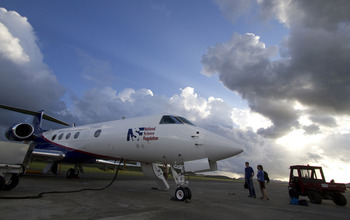National Science Foundation shares high-flying aircraft with NOAA for 2016 hurricane season
 The NSF/NCAR Gulfstream V readies for takeoff on a mission to study a tropical storm. Credit and Larger Version |
August 30, 2016
Hurricane forecasters will be ready for the upcoming peak of hurricane season, thanks to a partnership between the National Science Foundation (NSF) and the National Oceanic and Atmospheric Administration (NOAA) to share a high-altitude atmospheric science research plane.
NSF is providing its Gulfstream V (G-V) aircraft, operated by the National Center for Atmospheric Research (NCAR), to support NOAA hurricane forecasts through Oct. 12, while NOAA's Gulfstream IV (G-IV) undergoes unscheduled maintenance.
"One of the federal government's primary missions is to ensure the public's health and safety," said NSF Director France Córdova. "NSF is delighted that one of the scientific assets it supports, the G-V aircraft, can ensure a continuity of hurricane forecasting at this critical time of year."
Like NOAA's G-IV aircraft, the NSF/NCAR G-V can fly at high altitudes and deploy sensors that collect data used by the National Hurricane Center.
"It's critical to have detailed measurements of the atmosphere around a hurricane to ensure that forecasts are as accurate as possible," said Antonio (Tony) J. Busalacchi, president of the University Corporation for Atmospheric Research, which manages NCAR on behalf of NSF. "NCAR and its research partners have a proven track record of improving predictions of dangerous storms. Consistent with our role of managing NCAR, we take very seriously our ability and responsibility to share our advanced resources in support of NOAA's mission to protect life and property."
Outfitted for hurricane research
Surveillance flights will take place at the request of the National Hurricane Center, targeting storm systems that pose a high risk to the United States or have unusual uncertainties in hurricane model runs.
The NSF/NCAR G-V will be outfitted with the Airborne Vertical Atmospheric Profiling System (AVAPS). The system utilizes parachute-borne instrument packages, called GPS dropsondes -- developed by NCAR with NSF funding -- to obtain atmospheric profiles. The AVAPS system records high-resolution vertical profiles of ambient temperature, pressure, humidity, wind speed and wind direction.
NCAR pilots will guide the aircraft on pre-planned flight tracks, releasing dropsondes approximately every 15 minutes. Dropsondes launched from the aircraft will take measurements, then transmit their sensor data in real-time to the aircraft via radio link.
Data from the dropsondes will be processed by a NOAA technician aboard the plane, then sent to the World Meteorological Organization's Global Telecommunications System for immediate inclusion in hurricane forecast models.
Background on the NSF/NCAR G-V
The NSF Gulfstream-V High-performance Instrumented Airborne Platform for Environmental Research (G-V HIAPER) is designed to meet the needs of scientists who study Earth's environment and work in fields such as atmospheric chemistry and climate; chemical cycles; clouds and aerosols; solar and terrestrial radiative fluxes; upper troposphere-lower stratosphere processes; mountain waves and turbulence; air quality; and mesoscale weather.
The G-V can fly as high as 51,000 feet, allowing scientists to collect data from near the Earth's surface to the tops of storms and to the lower edge of the stratosphere. With a range of about 7,000 miles, the aircraft can reach remote locations, enabling atmospheric research from the North Pole to the South Pole. It can carry 5,600 pounds of state-of-the-art sensors. The G-V is housed at and operated by NCAR.
-NSF-
Media Contacts Peter West, NSF, (703) 292-7530,
pwest@nsf.gov
David Hosansky, NCAR, (303) 497-8611,
hosansky@ucar.edu
Related WebsitesVideo: NSF/NCAR G-V Aircraft: High-Flying Atmospheric Research: https://www.youtube.com/watch?v=ia0CkQ8qvpI&authuser=0
The National Science Foundation (NSF) is an independent federal agency that supports fundamental research and education across all fields of science and engineering. In fiscal year (FY) 2016, its budget is $7.5 billion. NSF funds reach all 50 states through grants to nearly 2,000 colleges, universities and other institutions. Each year, NSF receives more than 48,000 competitive proposals for funding and makes about 12,000 new funding awards. NSF also awards about $626 million in professional and service contracts yearly.
Useful NSF Web Sites:
NSF Home Page:
https://www.nsf.gov
NSF News:
https://www.nsf.gov/news/
For the News Media:
https://www.nsf.gov/news/newsroom.jsp
Science and Engineering Statistics:
https://www.nsf.gov/statistics/
Awards Searches:
https://www.nsf.gov/awardsearch/
The NSF/NCAR Gulfstream V in flight.
Credit and Larger Version

The Gulfstream V in Anchorage, Alaska, during research on global carbon dioxide distribution.
Credit and Larger Version

Inside the G-V: Scientist Eric Morgan with air samples taken above South America.
Credit and Larger Version
The National Science Foundation (NSF)
Guillermo Gonzalo Sánchez Achutegui
ayabaca@gmail.com
ayabaca@hotmail.com
ayabaca@yahoo.com
Incríbete en el Foro del blog y participa : A Vuelo De Un Quinde - El Foro!

No hay comentarios:
Publicar un comentario